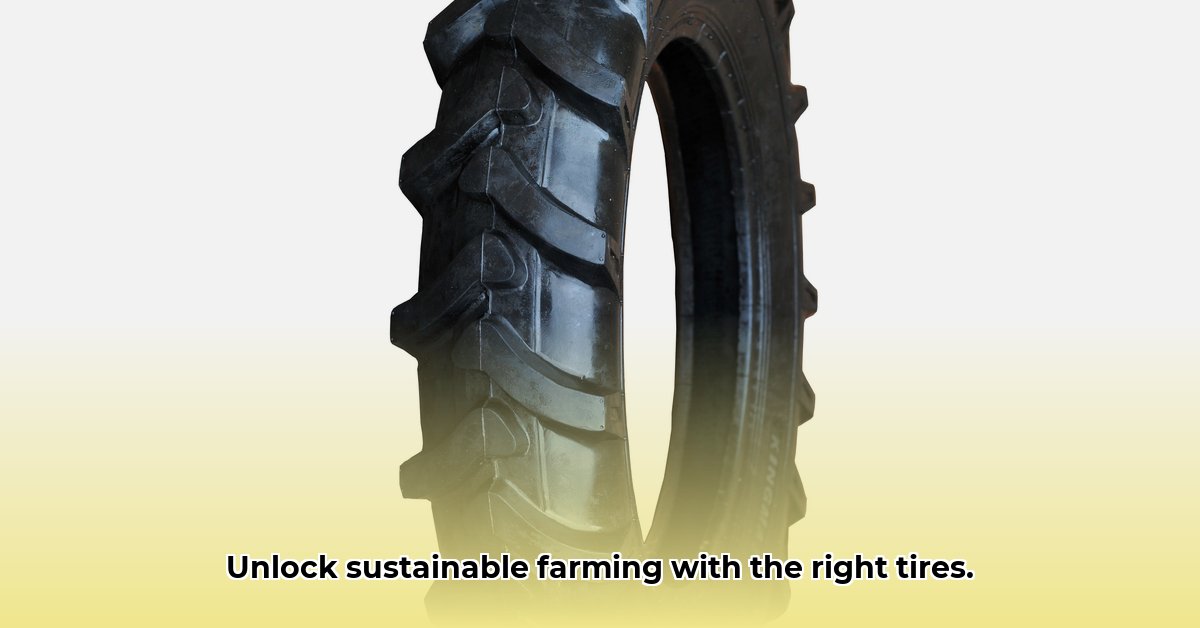
Choosing the right tractor tires is crucial for efficient and sustainable farming. This guide focuses on 9.5-24 front tractor tires, examining their impact on fuel consumption, soil health, and overall farm productivity. We'll explore key factors to consider when selecting tires and highlight the urgent need for more comprehensive data and industry transparency. For even larger tractors, check out larger tire options.
Understanding the Role of Front Tractor Tires in Sustainable Agriculture
While rear tires often dominate the conversation, front tires play a vital role in tractor performance and soil health. They influence steering, stability, and ground contact, directly impacting fuel efficiency and soil compaction. Improper tire selection can lead to increased fuel consumption, reduced crop yields, and long-term soil degradation. This is especially crucial when pursuing sustainable farming practices.
Decoding 9.5-24 Front Tractor Tires: Sustainability Considerations
The 9.5-24 designation denotes a common tire size. However, sustainability goes beyond mere dimensions. It encompasses the entire lifecycle of the tire – from manufacturing materials to end-of-life disposal. Minimizing the environmental footprint at each stage is paramount.
Key Factors for Choosing Sustainable 9.5-24 Front Tractor Tires
Selecting the optimal 9.5-24 front tractor tire requires considering several interconnected factors:
Traction (Grip): Effective grip is essential across varying soil conditions. Deeper treads generally offer superior traction, but the impact on soil compaction needs careful consideration. A balance between grip and minimal soil disturbance is crucial. Are you primarily working with clay, sandy or loamy soil? This will inform your tread depth choice.
Fuel Efficiency (Rolling Resistance): Lower rolling resistance translates to better fuel economy and reduced emissions. However, independently verified data comparing rolling resistance across different tire models is scarce. This data gap hinders informed decision-making.
Soil Compaction: Minimizing soil compaction is critical for sustainable agriculture. Tires with wider contact patches often distribute weight more effectively, reducing compaction. However, soil type plays a critical role – clay soils, for example, are more susceptible to compaction.
Tire Lifespan (Durability): A longer-lasting tire reduces waste and lowers the overall cost of ownership. Longer lifespan should not come at the cost of increased fuel consumption or higher soil compaction. A longer-lasting, fuel-efficient tire offers the best overall sustainability.
Eco-Friendly Materials and Recyclability: The use of recycled materials in tire manufacturing and the ease of tire recycling at the end-of-life are vital considerations. Unfortunately, many manufacturers lack transparency in disclosing this information, hindering informed decisions based on environmental impact.
A Step-by-Step Guide to Selecting Sustainable 9.5-24 Front Tractor Tires
Thorough Research: Consult available resources such as tractor manuals and manufacturer specifications. Be aware that comprehensive comparative data on tire performance and environmental impact are often limited.
Farmer Networks: Engage with fellow farmers to gather real-world experiences and insights on different tire models. Peer-to-peer knowledge sharing is invaluable.
Small-Scale Field Testing (If Feasible): If possible, conduct small-scale field trials with different tire types to directly assess their performance under your specific conditions. This provides localized data to complement manufacturer claims.
Total Cost of Ownership Analysis: Consider the total cost, including the initial purchase price, lifespan, fuel consumption, potential disposal costs, and the long-term impact on soil health. A holistic perspective helps in making informed buying decisions.
The Crucial Need for Improved Data and Transparency
A significant challenge is the lack of standardized testing procedures and transparent data on tire performance and environmental impact. We urge tire manufacturers to provide users with detailed performance metrics including rolling resistance, traction scores, and data regarding the environmental impact of production and disposal of their tires. Independent research institutions should focus on developing standardized testing protocols to ensure accurate and comparable data.
Conclusion: Collective Action for Sustainable Agriculture
Making informed tire choices is critical for sustainable agricultural practices. The lack of readily available data underscores the need for greater transparency from manufacturers and for more extensive, independent research. Farmers, researchers, and industry stakeholders must collaborate to establish standardized testing and promote data-driven decision making. This collective effort is paramount to advancing sustainable agriculture.